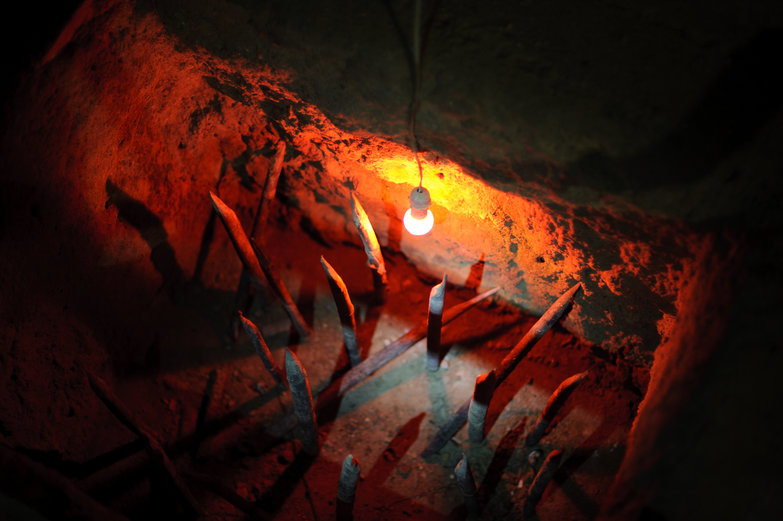Safely above ground, our guide takes us on a walk around the grounds, teaching us more about the tunnels. As he shows us tricks of the guerrilla's trade, we are in awe, totally and utterly impressed by the ingenuity and resourcefulness of the Củ Chi fighters.
For example, they used tiger traps for people:

…and made shoes out of enemy tires, which protected hundreds of soldiers' feet:
Downed American parachutes were scavenged and used to make camouflage ponchos:

…and the tunnel air vents were cleverly disguised to look like termite colonies:

Smoke from their underground kitchens was secretly split and channeled hundreds of meters away from the areas where the cooking took place. The tiny trickle of visible evidence that resulted was easily missed.
The two main responses in dealing with a tunnel opening were to flush the entrance with gas or water to force the guerrillas into the open, or to toss a few grenades down the hole and crimp off the opening. The clever design of the tunnels along with the strategic use of trap doors and air filtration systems rendered American technology ineffective.
Củ Chi Tunnels Wikipedia Article
The Củ Chi fighters compartmentalized knowledge of their tunnel systems. People only knew about the tunnels they built. Ignorance of the rest of the network meant that anyone being questioned or tortured couldn't give away the whereabouts or the plans to the rest of the hideout.
Numerous other safety precautions were taken as well. For instance, upon entering a tunnel, the guerrillas would put a landmine at the entrance. If an invader discovered their secret underground hideout(!), they would get blown up when they tried to get in.
If someone did manage to sneak in, there were spiked booby traps in all four corners of the underground meeting places. A soldier clearing a room would strafe left or right, heading for the relative safety of the corners. So much for that plan.

Another effective tactic involved shooting out of holes in the tunnels at ground level. It didn't matter that they wouldn't kill anyone this way; they reasoned that killing a solider was quick and easy, but wounding one meant more manpower and resources would be used to rescue and treat them.
It all really seems to illustrate a quote we saw at the War Remnants Museum:

These stealthy, complex tunnels systems, the stories of the brave, resourceful people who defnded them… it's all so freaking incredible. With homemade Swiss Family Robinson style defenses, these indomitable people fended off the US Army. They were unwilling to submit, and strong enough to endure the hardships of an underground, mole-like existence.

The role of the tunnel systems should not be underestimated in its importance to the Viet Cong in resisting American operations and protracting the war, eventually culminating in an American withdrawal.
Củ Chi Tunnels Wikipedia Article

